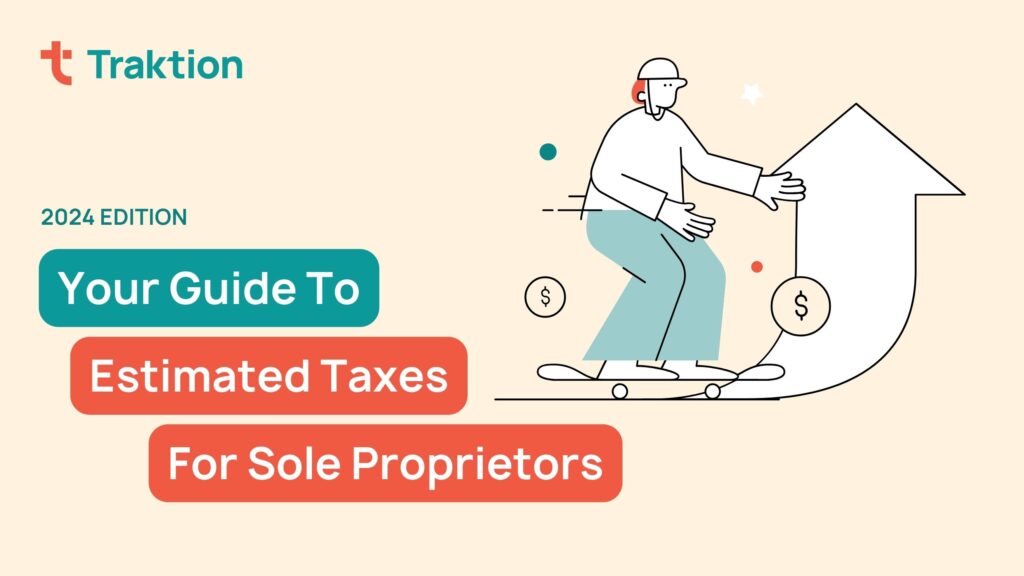Whether you’re new to estimated taxes or have been paying them for years, it’s always a good idea to brush up on the essentials when paying quarterly taxes for sole proprietors.
Getting Started: The Basics
As a sole proprietor, one of your responsibilities is paying estimated taxes throughout the year. These payments can be made using Form 1040-ES, which includes four stubs—one for each quarterly payment.
While employees who don’t own a business generally have their taxes withheld (from their paychecks), sole proprietors must handle their own estimated payments if their business generates income.
Here’s a quick breakdown:
- If you’re a business owner who made income this year, it’s likely that you’ll need to pay estimated taxes.
- Freelancers and independent contractors are also considered business owners, so you might need to pay estimated taxes depending on your income, deductions, and tax situation from the previous year.
- When in doubt, it’s always a smart idea to consult a tax professional to help determine your specific requirements.
If you’re unsure, it’s always a safer bet to pay estimated taxes during the year. It’s better to be prepared than to scramble at the last minute.
Quarterly Tax Payment Due Dates For Sole Proprietors
The next big question is: When are estimated taxes due?
Knowing these dates can help you organize your finances and make timely payments. If you don’t already have a tax savings account, consider setting one up. It’s an easy way to put aside funds specifically for your tax payments.
The IRS typically sets estimated tax payment deadlines on the 15th of the month, though dates can shift slightly due to weekends or holidays. Here’s the official word from the IRS:
“If the due date for making an estimated tax payment falls on a Saturday, Sunday, or legal holiday, the payment will be on time if you make it on the next day that isn’t a Saturday, Sunday, or legal holiday.”
Here are the estimated tax deadlines for 2024 & 2025:
- Q1 Payment: April 15, 2024
- Q2 Payment: June 17, 2024
- Q3 Payment: September 16, 2024
- Q4 Payment: January 15, 2025
And for 2025, mark these deadlines on your calendar:
- Q1 Payment: April 15, 2025
- Q2 Payment: June 16, 2025
- Q3 Payment: September 15, 2025
- Q4 Payment: January 15, 2026
Estimating the Amount Due
Now that we’ve covered the due dates, how do you calculate how much to pay?
The IRS uses the “safe harbor” rule, which provides two guidelines to help avoid penalties for underpaying taxes:
- The safe route: If your estimated payments, along with any tax withholdings, equal at least 100% of your previous year’s total tax liability, you won’t face penalties for underpayment (110% if your adjusted gross income exceeds $150,000).
- The riskier route: Alternatively, if your payments cover at least 90% of your estimated tax liability for the current year, you’ll avoid penalties. This requires more precise estimation of your income and tax situation throughout the year.
A good rule of thumb is to set aside roughly 30% of your net income each month in a separate savings account. That way, when quarterly taxes are due, you’ll have enough on hand to cover your estimated tax liability.
For a basic estimate, you can annualize your income for the first quarter by multiplying your Q1 earnings by four. From there, you can adjust your payments as the year progresses to reflect any changes in your business’s revenue.
Where to Pay Estimated Taxes Online
It’s easier than ever to make your estimated tax payments online. If you miss the mail pickup or simply prefer the convenience, you can pay your estimated taxes directly through the IRS website at irs.gov/payments.
There’s also the Electronic Federal Tax Payment System (EFTPS), which is commonly used for business tax payments, but for estimated taxes, most sole proprietors find the Direct Pay system simpler and faster.
When paying online, remember that:
- Payments must be submitted by 11:45 PM Eastern Time on the due date, or they’ll be considered late.
- The system is down for maintenance every Sunday for seven hours (early in the morning ET), but this rarely affects due dates.
To make a payment, select “Estimated Tax” as the reason and have your bank details and tax records ready. For those who prefer using a debit or credit card, keep in mind that there may be fees, especially for credit card payments, which usually involve a percentage of the amount paid.
Need More Help With Your Sole Prioprietorship Financials?
Managing the financials of your sole proprietorship can be challenging, from estimated taxes to cash flow management, but you don’t have to handle it all on your own.
At Traktion, we specialize in helping sole proprietors like you navigate the financial side of your business with ease.
Whether you need support with bookkeeping, financial goal-setting, or organizing your business’s finances, we’re here to be your financial coach.
Our experienced team works with small business owners to ensure they make smart financial decisions that help their businesses grow.
To get personalized advice and see how we can support you, visit our Contact page and schedule your first introductory call.
In the meantime, don’t hesitate to reach out for any questions about managing your business financials—we’re always here to help!
Until next time!
